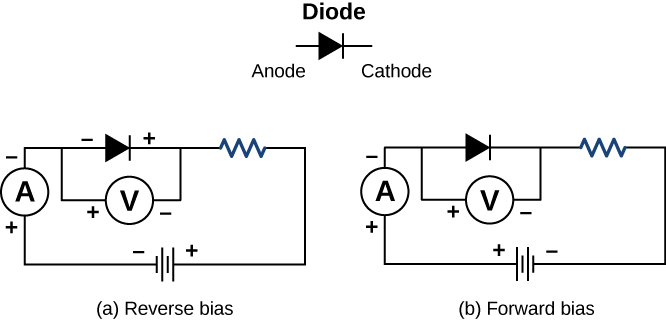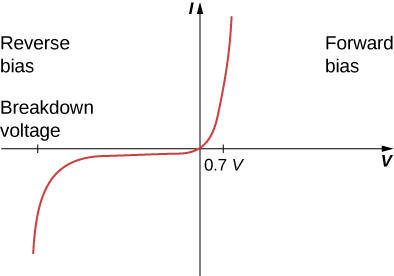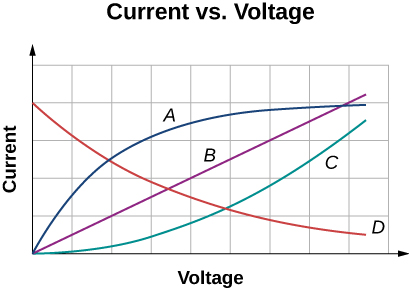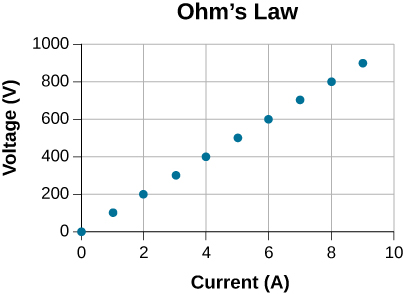| << Chapter < Page | Chapter >> Page > |

A plot of current versus voltage is shown in [link] . Note that the behavior of the diode is shown as current versus voltage, whereas the resistor operation was shown as voltage versus current. A diode consists of an anode and a cathode. When the anode is at a negative potential and the cathode is at a positive potential, as shown in part (a), the diode is said to have reverse bias. With reverse bias, the diode has an extremely large resistance and there is very little current flow—essentially zero current—through the diode and the resistor. As the voltage applied to the circuit increases, the current remains essentially zero, until the voltage reaches the breakdown voltage and the diode conducts current, as shown in [link] . When the battery and the potential across the diode are reversed, making the anode positive and the cathode negative, the diode conducts and current flows through the diode if the voltage is greater than 0.7 V. The resistance of the diode is close to zero. (This is the reason for the resistor in the circuit; if it were not there, the current would become very large.) You can see from the graph in [link] that the voltage and the current do not have a linear relationship. Thus, the diode is an example of a nonohmic device.

Ohm’s law is commonly stated as , but originally it was stated as a microscopic view, in terms of the current density, the conductivity, and the electrical field. This microscopic view suggests the proportionality comes from the drift velocity of the free electrons in the metal that results from an applied electrical field. As stated earlier, the current density is proportional to the applied electrical field. The reformulation of Ohm’s law is credited to Gustav Kirchhoff, whose name we will see again in the next chapter.
In Determining Field from Potential , resistance was defined as . In this section, we presented Ohm’s law, which is commonly expressed as . The equations look exactly alike. What is the difference between Ohm’s law and the definition of resistance?
Shown below are the results of an experiment where four devices were connected across a variable voltage source. The voltage is increased and the current is measured. Which device, if any, is an ohmic device?

Device B shows a linear relationship and the device is ohmic.
The current I is measured through a sample of an ohmic material as a voltage V is applied. (a) What is the current when the voltage is doubled to 2 V (assume the change in temperature of the material is negligible)? (b) What is the voltage applied is the current measured is 0.2 I (assume the change in temperature of the material is negligible)? What will happen to the current if the material if the voltage remains constant, but the temperature of the material increases significantly?
A resistor is connected across a D cell battery (1.5 V). What is the current through the resistor?
A resistor rated at is connected across two D cell batteries (each 1.50 V) in series, with a total voltage of 3.00 V. The manufacturer advertises that their resistors are within 5% of the rated value. What are the possible minimum current and maximum current through the resistor?
A resistor is connected in series with a power supply of 20.00 V. The current measure is 0.50 A. What is the resistance of the resistor?
A resistor is placed in a circuit with an adjustable voltage source. The voltage across and the current through the resistor and the measurements are shown below. Estimate the resistance of the resistor.

The following table show the measurements of a current through and the voltage across a sample of material. Plot the data, and assuming the object is an ohmic device, estimate the resistance.
| I (A) | V (V) |
|---|---|
| 0 | 3 |
| 2 | 23 |
| 4 | 39 |
| 6 | 58 |
| 8 | 77 |
| 10 | 100 |
| 12 | 119 |
| 14 | 142 |
| 16 | 162 |

Notification Switch
Would you like to follow the 'University physics volume 2' conversation and receive update notifications?